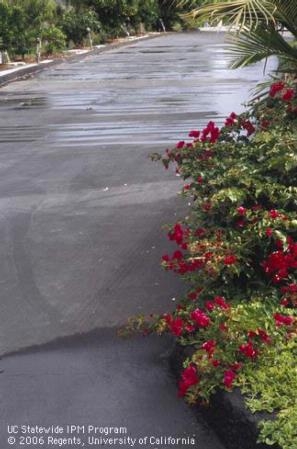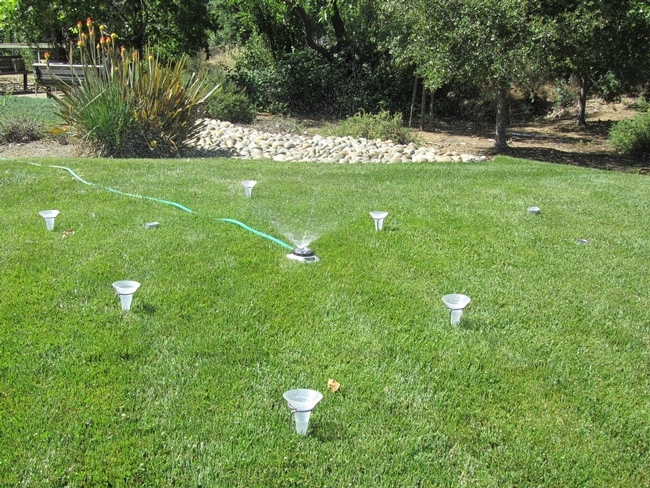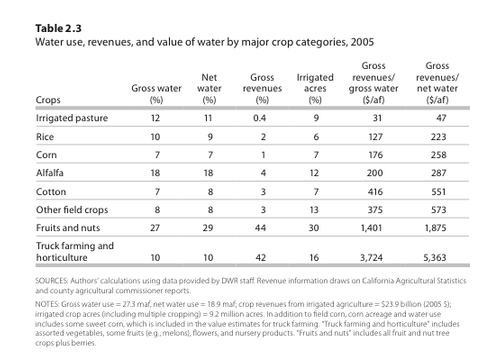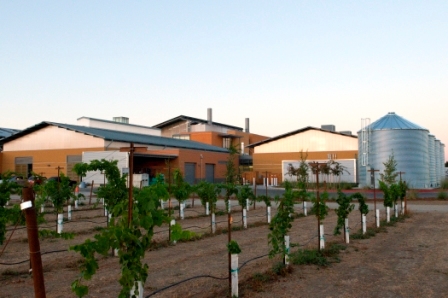Posts Tagged: water conservation
July's high evapotranspiration rates trigger conservation efforts
The Water Conservation Act of 2009, also referred to as Senate Bill x7-7 or “20 by 2020,” mandates that California reduce urban per capita water use by 20 percent by the year 2020. It also requires all water suppliers to increase water use efficiency.
It’s estimated that 50 percent of California’s residential water is used outdoors — to water lawns, ornamental plantings and vegetable gardens, and in swimming pools. Our water use practices can always become more efficient.
To help us become more aware of our watering practices, July is designated as Smart Irrigation Month by the national Irrigation Association. July is the month across most of North America when evapotranspiration rates are highest. The Irrigation Association uses the phrase “saved water is money in the bank” to draw attention to the need to water landscapes and gardens, golf courses and shopping center plantings more efficiently.
In a presentation in Groveland, Calif., Brad Lancaster, the author of “Rainwater Harvesting for Drylands and Beyond” asked the question, “Why do we use treated drinking water to irrigate our lawns?” The number one use of energy in California is to pump and move water.
Many of us in UC Cooperative Extension outreach are asked over and over during the hot, inland California summers: “How much should I water?” Although there are simple rules of thumb, the answer is, “It depends.” Effective irrigation depends on type of soil, slope, elevation, type of plants, where the plant is growing, etc.
The University of California Integrated Pest Management (IPM) website offers in-depth information for California residents interested in healthy lawn care and efficient irrigation. If you aren’t familiar with the website, check out the interactive irrigation testing and scheduling tools.
In addition to efficient irrigation scheduling, there are some fairly simple (and some not-so-simple) techniques that can help reduce outdoor residential water use:
- Check watering depth. A long screwdriver blade will penetrate easily into damp soil. Use it to gauge how deeply water is penetrating.
- Add organic material to the soil. Compost, homemade or purchased, helps clay soils drain and helps sandy soils retain moisture. Compost also reduces water demands, helps control soil erosion, and reduces plant stress from drought.
- To combat evaporation, plant closely enough that plants shade the soil.
- Mulch, mulch, mulch, mulch to slow evaporation from the soil surface.
- The amount of water needed varies by species of plant, the time of year, the amount of sunlight, air temperature, etc. The general rule of thumb is that turf grasses use up to about a quarter inch of water per day during the hottest part of the summer. To replace that almost two inches of water per week, divide the amount of water needed into one to three irrigations per week.
- Consider replacing some plantings with drought-tolerant natives.
- Consider reducing lawn size.
- Check sprinklers for leaks, broken heads, misaligned spray patterns and run-off.
- If water is running off, “cycle” irrigation. Run sprinklers until run-off appears, stop until water infiltrates, and repeat until deep irrigation is achieved.
For more information, see the UC Guide to Healthy Lawns.
Agricultural water conservation — a serious look
With this latest set of storms replenishing California’s snowpack and water levels in reservoirs, rivers and streams, it may be hard to think about water conservation issues. But this is a still a semi-arid state, so it is always prudent to prepare for droughts.
So where can we save the most water? Farming in California depends on irrigation, so agriculture seems the largest potential source for cost-effective water savings in the state. Although agriculture’s share has been declining, it still accounts for roughly 75 percent of all human water use, compared to 25 percent for urban uses.
The recent book, Managing California’s Water: From Conflict to Reconciliation, examines agricultural water conservation extensively and points out the complexity of this issue. The book’s findings are based on scientific and economic research and field experience in California and worldwide.
Much agricultural water is still devoted to relatively low-value crops: In 2005, over 60 percent of “net” water use in the agricultural sector – the amount consumed by crops – was for irrigation of pasture and field crops such as alfalfa, corn, rice, and cotton, which generated only 14 percent of crop revenues. These statistics imply significant potential for reducing farm water use without incurring overwhelming consequences for the state’s economy.
Contrary to popular understanding, however, improving on-farm irrigation efficiency is usually a poor way to achieve real agricultural water savings. Real conservation usually requires shifting to crops that use less water or reducing crop production, such as by fallowing farmland. This is because much of the irrigation water applied when farmers use “inefficient” techniques like furrow irrigation is returned to streams or aquifers, where it becomes available for reuse.
This is the international scientific consensus on irrigation conservation, from studies worldwide. Most groundwater recharge in California’s Central Valley is from irrigation runoff and percolation. This recharge helps to replenish depleted aquifers and serves as a significant source of supply during drought. Only a few areas in California, such as the Imperial Valley, can save large amounts of water by adopting more efficient irrigation techniques. In such areas, the excess irrigation water flows into saline water bodies or contaminated aquifers, where it is unavailable for reuse, so reducing runoff generates real water savings.
Even though improving irrigation efficiency usually does not produce significant real water savings, it can provide economic benefits for farmers. Farmers usually pay for the amount of water they apply to their fields, not the amount consumed by crops. When farmers face limited supplies, they often have an incentive to adopt more efficient techniques, such as drip irrigation, to make use of every possible drop on their farms.
These techniques, often combined with laser leveling of fields and more precise doses of fertilizers and pesticides, can improve crop productivity and quality. In recent decades, many San Joaquin Valley farmers have made such changes, which have enabled them to plant greater acreages of higher-value fruit, nut and vegetable crops.
Improving irrigation efficiency also can provide environmental benefits. For instance, agricultural runoff sometimes contains harmful salts and other chemicals, and more efficient irrigation can help reduce these discharges. This is another reason for the rise in more efficient irrigation techniques on the west side of the San Joaquin Valley, where farmers are required to limit runoff of selenium, a toxin to wildlife. Similarly, by reducing diversions, irrigation efficiency may allow higher streamflows on particular stretches of rivers, improving conditions for aquatic life.
Although counterintuitive, more efficient irrigation techniques also can increase water consumption. By allowing farmers to farm their fields more intensively and to expand irrigated acreage with the water they “save,” techniques like drip irrigation can increase net farm water use within a region, thereby reducing groundwater recharge and nearby streamflow. Conservation-oriented policies that neglect this possibility can exacerbate groundwater overdraft, as studies from New Mexico to Yemen have shown.
What is the right policy to encourage effective agricultural water conservation? It depends on the objective. To encourage real water savings, the best policy is to let market forces work. Water markets are a flexible and efficient way to encourage farmers to create real water savings for higher-valued uses. California needs to improve the ability to buy and sell water, by reducing state and local barriers, to give farmers better price signals. To reduce polluted agricultural runoff or improve streamflows in some areas, the best policy is to adopt regulations that directly address pollution discharges and instream flows, and allow farmers to choose the most cost-effective way to meet these requirements.
In contrast, policies that impose particular irrigation technologies, or even ban specific crops, are likely to impose higher costs on farmers and society, while failing to save real water. Given the immense variety and variability of conditions in California, rigid regulatory policies to promote agricultural water conservation seem more likely to create more controversy and increased social cost than usable water savings.
Agricultural water conservation is an important part of California’s water future. But simplistic notions of water conservation threaten to mislead California’s water policy debates by presenting the false claim that water saved from on-farm use is necessarily water saved to the system. It is time to take water conservation seriously. In doing so, we also must undertake water conservation scientifically, rather than rhetorically.
(This post is excerpted from the California WaterBlog—“Taking Agricultural Conservation Seriously”.)
World's first LEED Platinum winery, brewery and food-processing labs
A new winery, brewery and food-processing complex at the University of California, Davis, is the most environmentally sophisticated complex of its kind in the world, one that promises to unravel scientific enigmas and solve practical problems related to foods, beverages and health.
The $20 million, 34,000-square-foot teaching-and-research complex is the first winery, brewery or food-processing facility expected to earn LEED Platinum certification, the highest environmental rating awarded by the U.S. Green Building Council. It is intended to become self-sustainable in energy and water use.
Neal Van Alfen, dean of the College of Agricultural and Environmental Sciences at UC Davis, said, "It will serve as a model for industries throughout the nation that are also committed both to environmental excellence and production efficiency."
The complex houses a brewery, general foods-processing plant, milk-processing laboratory, and a teaching-and-research winery which will serve as a test bed for production processes that conserve water, energy, and other resources. The complex is adjacent to a 12-acre teaching-and-research vineyard.
Its environmentally friendly features include on-site solar power generation, a large-capacity system for capturing rainwater and conserving processing water, and many other features. The facility is expected to be carbon zero in carbon emissions.
Read more about the facility and take an online tour at the facility’s website.









